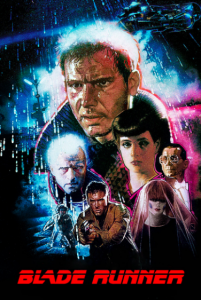By Michael Adair
I’ll always remember the first time I saw Blade Runner: on a rainy October evening in 2009 as part of the short-lived Film4 ‘retro sci-fi season’. However, as a bright eyed 11 year-old, I failed to understand the cultural significance of Ridley Scott’s dark neo-noir re-imagining of a futuristic 2019 San Francisco (a setting which would go on to influence other works such as Akira, 2000AD’s Dredd, District 9, and Ghost In The Shell to name but a few).

The atmosphere of the environment in which the story takes place is a huge part of Blade Runner. At the time of production (1981) practical effects were on the way out as, with the introduction of minor CGI, they were seen as timely and expensive to investors; often requiring triple the crew of a computer generated feature and dozens of man hours. This resulted in a huge amount of stress surrounding Blade Runner’s production, as director (Ridley Scott) and crew would have to make tireless efforts to complete the film whilst keeping the studio and investors happy. After all the film was released in 1982: the same year as the majorly successful TRON (the first extensive use of CGI tech).
1982 was a great year for cinema, with many now-classic movies being released, such as the aforementioned TRON, Mad Max 2, Conan, The Thing, Star Trek II, First Blood, Poltergeist, 48 Hours, The Dark Crystal, Rocky III, and of course E.T.
1982. E.T. would dominate that year, becoming one of the most popular films ever made. Audiences watched it repeatedly at the cinema, generally ignoring others films at the time. Obviously not all releases were effected by E.T., but it came out 2 weeks before Blade Runner, discernibly depleting the audience numbers of Ridley Scott’s contemplative SF noir master-class.
Critics at the time were blown away Blade Runner’s visuals, but many also highlighted its slow pacing and uninteresting characters, resulting in them not being interested in its characters or story. For its first weekend the box office numbers were great, but soon the numbers began to drop through negative word-of-mouth, most people admitting to have been just confused by it. After all, the marketing campaign showcased an action driven adrenalin fuelled sci-fi movie which was far from what it ultimately delivers.
Once it was pulled from screens due to its poor performance, many theatres began to do midnight showings. By 1983 it had began to amass an audience who had failed to see it on its previous release, building up the recognition it deserved becoming a cult classic in a short space of time. Today Blade Runner is regarded by many as one of the most important science fictions films ever made.
Despite its status, Blade Runner still divides many movie goers, with some hailing its genius, while others sully its apparent failed attempts at grandeur. Regardless of standpoint, Blade Runner‘s contribution to the style of urban post-apocalypse science fiction in terms of both writing and cinematography is clear, with countlessly soulless pieces of work trying to “replicate” the same themes of economic disparity, robo-slavery, gender imbalances, and unjust poverty (often resulting in a lead who wears a raggedy scarf, while saying very little, and probably defying gender boundaries or something “brave” like that.)
For me, its the lack of pandering that make Blade Runner special. The world of the film feels tactile and real because of the lack of traditional pace and structure, stunningly timeless visuals, and original dialogue (which serves as a world building device; not a plot device).
With Blade Runner, you get back what you put in: going into the film if you expect an action packed thrill ride akin to Ford’s previous roles in Star Wars and Indiana Jones then you’ll be disappointed and bored beyond belief. However, if you’re a sci-fi fan whose completely dishearten with the frankly bland unoriginal bantha fodder that graces bookshelves and market tested ‘cinematic universes’ up and down the country then Blade Runner acts as an interesting look into a quieter corner of the genre. The film takes place in three locations, and achieves more worldly depth than the apparent sprawling breathtaking vistas of 2009’s Avatar, 2014’s Interstellar, and 1999’s The Matrix.
Also, Deckard isn’t a replicant. Period.